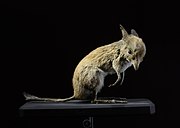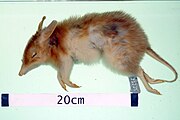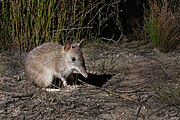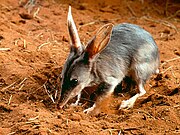List of peramelemorphs


Peramelemorphia is an order of Australian marsupial mammals. Members of this order are called peramelemorphs and include bandicoots and bilbies. They are found in Australia and New Guinea, generally in forests, shrublands, grasslands, and savannas, though some species are found in inland wetlands and deserts. They range in size from the Arfak pygmy bandicoot, at 14 cm (6 in) plus a 11 cm (4 in) tail, to the giant bandicoot, at 56 cm (22 in) plus a 34 cm (13 in) tail. Peramelemorphs primarily eat insects and fruit, as well as other invertebrates and small vertebrates. Most peramelemorphs do not have population estimates, but the ones that do range from 1,000 to 100,000 mature individuals. The giant bandicoot, David's echymipera, and Seram bandicoot are endangered. The desert bandicoot, lesser bilby, and pig-footed bandicoot were driven to extinction in the mid-1900s.
The nineteen extant species of Peramelemorphia are divided into two families: Peramelidae, containing eighteen species divided between three genera in the subfamily Echymiperinae, two genera in the subfamily Peramelinae, and a single genus in the subfamily Peroryctinae; and Thylacomyidae, containing one extant species in a single genus. Additionally, Peramelemorphia includes the extinct family Chaeropodidae, containing a single species. Dozens of extinct, prehistoric Peramelemorphia species have been discovered, though due to ongoing research and discoveries the exact number and categorization is not fixed.[1]
Conventions
| Conservation status | |
|---|---|
| EX | Extinct (3 species) |
| EW | Extinct in the wild (0 species) |
| CR | Critically Endangered (0 species) |
| EN | Endangered (3 species) |
| VU | Vulnerable (6 species) |
| NT | Near threatened (0 species) |
| LC | Least concern (9 species) |
| Other categories | |
| DD | Data deficient (1 species) |
| NE | Not evaluated (0 species) |
Conservation status codes listed follow the International Union for Conservation of Nature (IUCN) Red List of Threatened Species. Range maps are provided wherever possible; if a range map is not available, a description of the peramelemorph's range is provided. Ranges are based on the IUCN Red List for that species unless otherwise noted. All extinct species or subspecies listed alongside extant species went extinct after 1500 CE, and are indicated by a dagger symbol "†".
Classification
The order Peramelemorphia consists of nineteen extant species in two extant families, Peramelidae and Thylacomyidae. Peramelidae is divided into three subfamilies: Echymiperinae, containing ten species in three genera; Peramelinae, containing six species in two genera; and Peroryctinae, containing a single species. Thylacomyidae consists of one extant species. Additionally, Peramelemorphia includes the extinct family Chaeropodidae, containing a single species. Three species have been driven to extinction in recent times, all in the mid-1900s: the desert bandicoot in Peramelinae, the lesser bilby in Thylacomyidae, and the pig-footed bandicoot in Chaeropodidae. Many of these species are further subdivided into subspecies. This does not include hybrid species or extinct prehistoric species.
Family Chaeropodidae†
- Genus Chaeropus† (pig-footed bandicoots): one species (one extinct)
Family Peramelidae
- Subfamily Echymiperinae
- Genus Echymipera (New Guinean spiny bandicoots): five species
- Genus Microperoryctes (New Guinean mouse bandicoots): four species
- Genus Rhynchomeles (Seram bandicoot): one species
- Subfamily Peramelinae
- Subfamily Peroryctinae
- Genus Peroryctes (New Guinean long-nosed bandicoots): two species
Family Thylacomyidae
- Genus Macrotis (bilbies): two species (one extinct)
Peramelemorphs
The following classification is based on the taxonomy described by the reference work Mammal Species of the World (2005), with augmentation by generally accepted proposals made since using molecular phylogenetic analysis, as supported by both the IUCN and the American Society of Mammalogists.[3]
Chaeropodidae
| Common name | Scientific name and subspecies | Range | Size and ecology | IUCN status and estimated population |
|---|---|---|---|---|
| Pig-footed bandicoot† | C. ecaudatus[a] (Ogilby, 1838) |
Central and western Australia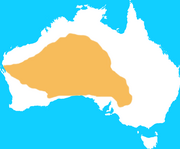
|
Size: 23–26 cm (9–10 in) long, plus 10–14 cm (4–6 in) tail[4] Habitat: Forest, savanna, shrubland, and grassland[5] Diet: Believed to be omnivorous[4] |
EX
|
Peramelidae
Subfamily Echymiperinae
| Common name | Scientific name and subspecies | Range | Size and ecology | IUCN status and estimated population |
|---|---|---|---|---|
| Clara's echymipera
|
E. clara Stein, 1932 |
Northern New Guinea
|
Size: 20–50 cm (8–20 in) long, plus 5–13 cm (2–5 in) tail[6] Habitat: Forest[7] Diet: Omnivorous, primarily fruit[6] |
LC
|
| Common echymipera
|
E. kalubu (J. B. Fischer, 1829) Four subspecies
|
New Guinea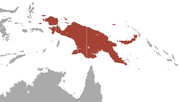
|
Size: 22–38 cm (9–15 in) long, plus 8 cm (3 in) tail[8] Habitat: Inland wetlands and forest[9] Diet: Invertebrates and fruit[8] |
LC
|
| David's echymipera
|
E. davidi Flannery, 1990 |
Kiriwina island east of New Guinea
|
Size: 20–50 cm (8–20 in) long, plus 5–13 cm (2–5 in) tail[6] Habitat: Forest[10] Diet: Omnivorous[6] |
EN
|
| Long-nosed echymipera
|
E. rufescens (Peters, Doria, 1875) Two subspecies
|
New Guinea and northeastern Australia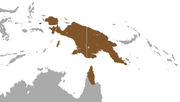
|
Size: 20–50 cm (8–20 in) long, plus 5–13 cm (2–5 in) tail[11] Habitat: Forest, shrubland, and grassland[12] Diet: Fruit, seeds, invertebrates, fungi, and plants[11] |
LC
|
| Menzies' echymipera
|
E. echinista Menzies, 1990 |
Southern New Guinea
|
Size: 20–50 cm (8–20 in) long, plus 5–13 cm (2–5 in) tail[6] Habitat: Savanna and forest[13] Diet: Omnivorous[6] |
DD
|
| Common name | Scientific name and subspecies | Range | Size and ecology | IUCN status and estimated population |
|---|---|---|---|---|
| Arfak pygmy bandicoot
|
M. aplini Helgen, Flannery, 2004 |
Western New Guinea
|
Size: 14–16 cm (6 in) long, plus 11–12 cm (4–5 in) tail[14] Habitat: Forest[15] Diet: Insects as well as fruit[16] |
VU
|
| Mouse bandicoot
|
M. murina Stein, 1932 |
Western New Guinea
|
Size: 15–18 cm (6–7 in) long, plus 10–11 cm (4 in) tail[17] Habitat: Forest[18] Diet: Insects as well as fruit[16] |
VU
|
| Papuan bandicoot
|
M. papuensis (Laurie, 1952) |
Eastern New Guinea
|
Size: 17–20 cm (7–8 in) long, plus 13–16 cm (5–6 in) tail[17] Habitat: Forest[19] Diet: Insects as well as fruit[16] |
LC
|
| Striped bandicoot | M. longicauda (Peters, Doria, 1876) Three subspecies
|
New Guinea
|
Size: 23–31 cm (9–12 in) long, plus 14–26 cm (6–10 in) tail[17] Habitat: Forest and grassland[20] Diet: Insects as well as fruit[16] |
LC
|
| Common name | Scientific name and subspecies | Range | Size and ecology | IUCN status and estimated population |
|---|---|---|---|---|
| Seram bandicoot
|
R. prattorum Thomas, 1920 |
Seram Island west of New Guinea
|
Size: 24–33 cm (9–13 in) long, plus 10–13 cm (4–5 in) tail[21] Habitat: Forest[22] Diet: Unknown[21] |
EN
|
Subfamily Peramelinae
| Common name | Scientific name and subspecies | Range | Size and ecology | IUCN status and estimated population |
|---|---|---|---|---|
| Golden bandicoot | I. auratus (Ramsay, 1887) Three subspecies
|
Northwestern Australia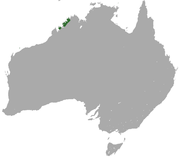
|
Size: 19–30 cm (7–12 in) long, plus 8–13 cm (3–5 in) tail[23] Habitat: Savanna, shrubland, and grassland[24] Diet: Insects and arachnids, as well as turtle eggs, small reptiles, and plant material[25] |
VU
|
| Northern brown bandicoot | I. macrourus (Gould, 1842) Two subspecies
|
Northern and eastern Australia and southern New Guinea (former in black)
|
Size: 30–47 cm (12–19 in) long, plus 8–22 cm (3–9 in) tail[26] Habitat: Forest, savanna, shrubland, and grassland[27] Diet: Insects, as well as lizards, birds, plant matter, and fungi[26] |
LC
|
| Southern brown bandicoot | I. obesulus (Shaw, 1797) Two subspecies
|
Southwestern and southeastern Australia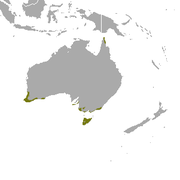
|
Size: 28–36 cm (11–14 in) long, plus 9–14 cm (4–6 in) tail[28] Habitat: Forest, shrubland, grassland, and inland wetlands[29] Diet: Plants, fungi, and invertebrates[30] |
LC
|
| Common name | Scientific name and subspecies | Range | Size and ecology | IUCN status and estimated population |
|---|---|---|---|---|
| Desert bandicoot† | P. eremiana Spencer, 1897 |
Central Australia | Size: 20–43 cm (8–17 in) long, plus 7–17 cm (3–7 in) tail[31] Habitat: Shrubland, grassland, and desert[32] Diet: Believed to be insects, as well as worms, snails, mice, lizards, and plants[31] |
EX
|
| Eastern barred bandicoot | P. gunnii Gray, 1838 |
Southern Australia
|
Size: 20–43 cm (8–17 in) long, plus 7–17 cm (3–7 in) tail[31] Habitat: Grassland[33] Diet: Insects and arachnids, as well as small vertebrates and plants[34] |
VU
|
| Long-nosed bandicoot | P. nasuta Geoffroy, 1804 |
Eastern Australia
|
Size: 20–43 cm (8–17 in) long, plus 7–17 cm (3–7 in) tail[31] Habitat: Forest, shrubland, and grassland[35] Diet: Insects, arachnids, small vertebrates, plant roots, and fungi[36] |
LC
|
| Western barred bandicoot | P. bougainville Quoy, Gaimard, 1824 |
Scattered western and central Australia
|
Size: 20–43 cm (8–17 in) long, plus 7–17 cm (3–7 in) tail[31] Habitat: Shrubland and grassland[37] Diet: Invertebrates, plants, roots, herbs, seeds, berries, and fungi, as well as small vertebrates[38] |
VU
|
Subfamily Peroryctinae
| Common name | Scientific name and subspecies | Range | Size and ecology | IUCN status and estimated population |
|---|---|---|---|---|
| Giant bandicoot
|
P. broadbenti (Ramsay, 1879) |
Eastern New Guinea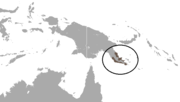
|
Size: 39–56 cm (15–22 in) long, plus 11–34 cm (4–13 in) tail[39] Habitat: Forest[40] Diet: Believed to be omnivorous[40] |
EN
|
| Raffray's bandicoot | P. raffrayana (Milne-Edwards, 1878) Two subspecies
|
New Guinea
|
Size: 17–39 cm (7–15 in) long, plus 11–23 cm (4–9 in) tail[39] Habitat: Forest, shrubland, and grassland[41] Diet: Insects, as well as other invertebrates, small vertebrates, and plants[42] |
LC
|
Thylacomyidae
| Common name | Scientific name and subspecies | Range | Size and ecology | IUCN status and estimated population |
|---|---|---|---|---|
| Greater bilby | M. lagotis Reid, 1837 |
Western and central Australia
|
Size: 29–55 cm (11–22 in) long, plus 20–29 cm (8–11 in) tail[43] Habitat: Savanna and grassland[44] Diet: Seeds, bulbs, invertebrates, fruit, fungi, and lizards, as well as eggs and small mammals[45] |
VU
|
| Lesser bilby† | M. leucura Thomas, 1887 |
Central Australia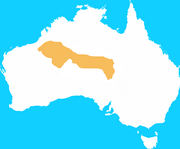
|
Size: 20–27 cm (8–11 in) long, plus 12–17 cm (5–7 in) tail[43] Habitat: Savanna, shrubland, and grassland[46] Diet: Insects, fruit, seeds, and fungi[47] |
EX
|
Notes
- ^ Although it is not recognized as such by the IUCN, Chaeropus ecaudatus is sometimes split into the southern pig-footed bandicoot (C. ecaudatus) and northern pig-footed bandicoot (C. yirratji).
References
- ^ "Fossilworks: Peramelemorphia". Paleobiology Database. University of Wisconsin–Madison. Retrieved April 5, 2023.
- ^ Meredith, R. W.; Westerman, M.; Springer, M. S. (2008). "A timescale and phylogeny for "Bandicoots" (Peramelemorphia: Marsupialia) based on the sequences for five nuclear genes". Molecular Phylogenetics and Evolution. 47 (1): 1–20. doi:10.1016/j.ympev.2008.01.002. PMID 18328736.
- ^ Wilson, Reeder, pp. 38–42
- ^ a b Nowak 2005, p. 124
- ^ a b Burbidge, A. A.; Woinarski, J. (2016). "Chaeropus ecaudatus". IUCN Red List of Threatened Species. 2016: e.T4322A21965168. doi:10.2305/IUCN.UK.2016-2.RLTS.T4322A21965168.en.
- ^ a b c d e f Nowak 2005, p. 128
- ^ a b Leary, T.; Wright, D.; Hamilton, S.; Singadan, R.; Menzies, J.; Bonaccorso, F.; Salas, L.; Seri, L.; Dickman, C.; Helgen, K.; Aplin, K. (2016). "Echymipera clara". IUCN Red List of Threatened Species. 2016: e.T7015A21966942. doi:10.2305/IUCN.UK.2016-2.RLTS.T7015A21966942.en.
- ^ a b Tran, Nghi (2023). "Echymipera kalubu". Animal Diversity Web. University of Michigan. Retrieved April 5, 2023.
- ^ a b Leary, T.; Wright, D.; Hamilton, S.; Singadan, R.; Menzies, J.; Bonaccorso, F.; Helgen, K.; Seri, L.; Aplin, K.; Dickman, C.; Salas, L. (2016). "Echymipera kalubu". IUCN Red List of Threatened Species. 2016: e.T7018A21966845. doi:10.2305/IUCN.UK.2016-2.RLTS.T7018A21966845.en.
- ^ a b Leary, T.; Wright, D.; Hamilton, S.; Singadan, R.; Menzies, J.; Bonaccorso, F.; Helgen, K.; Seri, L. (2016). "Echymipera davidi". IUCN Red List of Threatened Species. 2016: e.T7017A21966774. doi:10.2305/IUCN.UK.2016-2.RLTS.T7017A21966774.en.
- ^ a b Hart, Myha (2012). "Echymipera rufescens". Animal Diversity Web. University of Michigan. Retrieved April 5, 2023.
- ^ a b Leary, T.; Wright, D.; Hamilton, S.; Singadan, R.; Menzies, J.; Bonaccorso, F.; Helgen, K.; Seri, L.; Allison, A.; Winter, J.; Aplin, K.; Dickman, C.; Salas, L. (2016). "Echymipera rufescens". IUCN Red List of Threatened Species. 2016: e.T7019A21966655. doi:10.2305/IUCN.UK.2016-2.RLTS.T7019A21966655.en.
- ^ a b Leary, T.; Wright, D.; Hamilton, S.; Singadan, R.; Menzies, J.; Bonaccorso, F.; Helgen, K.; Seri, L.; Aplin, K.; Dickman, C.; Salas, L. (2016). "Echymipera echinista". IUCN Red List of Threatened Species. 2016: e.T7016A21967022. doi:10.2305/IUCN.UK.2016-2.RLTS.T7016A21967022.en.
- ^ Helgen, K. M.; Flannery, T. F. (2004). "A new species of bandicoot, Microperoryctes aplini, from western New Guinea". Journal of Zoology. 264: 117–124. doi:10.1017/S0952836904005667.
- ^ a b Leary, T.; Wright, D.; Hamilton, S.; Singadan, R.; Menzies, J.; Bonaccorso, F. J.; Helgen, K.; Seri, L. (2019). "Microperoryctes aplini". IUCN Red List of Threatened Species. 2019: e.T136538A21965745. doi:10.2305/IUCN.UK.2019-1.RLTS.T136538A21965745.en.
- ^ a b c d Nowak 2018, p. 214
- ^ a b c Nowak 2005, p. 130
- ^ a b Leary, T.; Wright, D.; Hamilton, S.; Singadan, R.; Menzies, J.; Bonaccorso, F. J.; Helgen, K.; Seri, L.; Aplin, K.; Dickman, C.; Salas, L. (2019). "Microperoryctes murina". IUCN Red List of Threatened Species. 2019: e.T13389A21965585. doi:10.2305/IUCN.UK.2019-1.RLTS.T13389A21965585.en.
- ^ a b Leary, T.; Wright, D.; Hamilton, S.; Singadan, R.; Menzies, J.; Bonaccorso, F.; Helgen, K.; Seri, L.; Allison, A.; Aplin, K.; Dickman, C.; Salas, L. (2016). "Microperoryctes papuensis". IUCN Red List of Threatened Species. 2016: e.T13390A21965507. doi:10.2305/IUCN.UK.2016-2.RLTS.T13390A21965507.en.
- ^ a b Leary, T.; Wright, D.; Hamilton, S.; Singadan, R.; Menzies, J.; Bonaccorso, F. J.; Helgen, K.; Seri, L.; Aplin, K.; Dickman, C.; Salas, L. (2016). "Microperoryctes longicauda". IUCN Red List of Threatened Species. 2016: e.T84783217A21965649. doi:10.2305/IUCN.UK.2016-3.RLTS.T84783217A21965649.en.
- ^ a b Nowak 2005, p. 129
- ^ a b Leary, T.; Wright, D.; Hamilton, S.; Singadan, R.; Menzies, J.; Bonaccorso, F.; Helgen, K.; Seri, L.; Allison, A.; Aplin, K.; Dickman, C.; Salas, L. (2016). "Rhynchomeles prattorum". IUCN Red List of Threatened Species. 2016: e.T19711A21967091. doi:10.2305/IUCN.UK.2016-2.RLTS.T19711A21967091.en.
- ^ Strahan, p. 173
- ^ a b Burbidge, A. A.; Woinarski, J. (2017) [errata version of 2016 assessment]. "Isoodon auratus". IUCN Red List of Threatened Species. 2016: e.T10863A115100163. doi:10.2305/IUCN.UK.2016-3.RLTS.T10863A21966258.en.
- ^ Norlin, Molly (2012). "Isoodon auratus". Animal Diversity Web. University of Michigan. Retrieved April 5, 2023.
- ^ a b Szaura, Troy (2018). "Isoodon macrourus". Animal Diversity Web. University of Michigan. Retrieved April 5, 2023.
- ^ a b Lunney, D.; Dickman, C.; Woinarski, J. (2016). "Isoodon macrourus". IUCN Red List of Threatened Species. 2016: e.T40552A21966494. doi:10.2305/IUCN.UK.2016-2.RLTS.T40552A21966494.en.
- ^ Strahan, p. 176
- ^ a b Burbidge, A. A.; Woinarski, J. (2017) [errata version of 2016 assessment]. "Isoodon obesulus". IUCN Red List of Threatened Species. 2016: e.T40553A115173603. doi:10.2305/IUCN.UK.2016-3.RLTS.T40553A21966368.en.
- ^ Blevins, Kasey (2022). "Isoodon obesulus". Animal Diversity Web. University of Michigan. Retrieved April 5, 2023.
- ^ a b c d e Nowak 2005, p. 126
- ^ a b Burbidge, A. A.; Woinarski, J. (2016). "Perameles eremiana". IUCN Red List of Threatened Species. 2016: e.T16570A21965953. doi:10.2305/IUCN.UK.2016-3.RLTS.T16570A21965953.en.
- ^ a b Woinarski, J.; Burbidge, A. A. (2016). "Perameles gunnii". IUCN Red List of Threatened Species. 2016: e.T16572A21966027. doi:10.2305/IUCN.UK.2016-2.RLTS.T16572A21966027.en.
- ^ Lancaster, Eric (2001). "Perameles gunnii". Animal Diversity Web. University of Michigan. Retrieved April 5, 2023.
- ^ a b Lunney, D.; Dickman, C.; Menkhorst, P. (2017) [errata version of 2016 assessment]. "Perameles nasuta". IUCN Red List of Threatened Species. 2016: e.T40554A115173969. doi:10.2305/IUCN.UK.2016-3.RLTS.T40554A21966169.en.
- ^ Adam, Ryan (2015). "Perameles nasuta". Animal Diversity Web. University of Michigan. Retrieved April 5, 2023.
- ^ a b Burbidge, A. A.; Woinarski, J. (2016). "Perameles bougainville". IUCN Red List of Threatened Species. 2016: e.T16569A21965819. doi:10.2305/IUCN.UK.2016-1.RLTS.T16569A21965819.en.
- ^ Rochefort, Laura (2013). "Perameles bougainville". Animal Diversity Web. University of Michigan. Retrieved April 5, 2023.
- ^ a b Nowak 2018, p. 208
- ^ a b c Leary, T.; Wright, D.; Hamilton, S.; Singadan, R.; Menzies, J.; Bonaccorso, F.; Helgen, K.; Seri, L.; Allison, A.; Aplin, K.; Dickman, C.; Salas, L. (2016). "Peroryctes broadbenti". IUCN Red List of Threatened Species. 2016: e.T16710A21965270. doi:10.2305/IUCN.UK.2016-2.RLTS.T16710A21965270.en.
- ^ a b Leary, T.; Wright, D.; Hamilton, S.; Singadan, R.; Menzies, J.; Bonaccorso, F.; Helgen, K.; Seri, L.; Allison, A.; Aplin, K.; Dickman, C.; Salas, L. (2016). "Peroryctes raffrayana". IUCN Red List of Threatened Species. 2016: e.T16711A21965412. doi:10.2305/IUCN.UK.2016-2.RLTS.T16711A21965412.en.
- ^ Kennedy, Karen (2023). "Peroryctes raffrayana". Animal Diversity Web. University of Michigan. Retrieved April 5, 2023.
- ^ a b Nowak 2005, p. 122
- ^ a b Burbidge, A. A.; Woinarski, J. (2016). "Macrotis lagotis". IUCN Red List of Threatened Species. 2016: e.T12650A21967189. doi:10.2305/IUCN.UK.2016-2.RLTS.T12650A21967189.en.
- ^ Brown, Emily (2011). "Macrotis lagotis". Animal Diversity Web. University of Michigan. Retrieved April 5, 2023.
- ^ a b Burbidge, A. A.; Woinarski, J. (2016). "Macrotis leucura". IUCN Red List of Threatened Species. 2016: e.T12651A21967376. doi:10.2305/IUCN.UK.2016-2.RLTS.T12651A21967376.en.
- ^ Singh, Angela (2001). "Macrotis leucura". Animal Diversity Web. University of Michigan. Retrieved April 5, 2023.
Sources
- Groves, Colin P. (2005). Wilson, Don E.; Reeder, DeeAnn M. (eds.). Mammal Species of the World. Vol. 1 (3rd ed.). Johns Hopkins University Press. ISBN 978-0-8018-8221-0.
- Nowak, Ronald M. (2005). Walker's Marsupials of the World. Johns Hopkins University Press. ISBN 978-0-8018-8222-7.
- Nowak, Ronald M. (2018). Walker's Mammals of the World. Vol. Monotremes, Marsupials, Afrotherians, Xenarthrans, and Sundatherians. Johns Hopkins University Press. ISBN 978-1-4214-2468-2.
- Strahan, Ronald (1995). Mammals of Australia. Smithsonian Institution. ISBN 978-1-56098-673-7.
